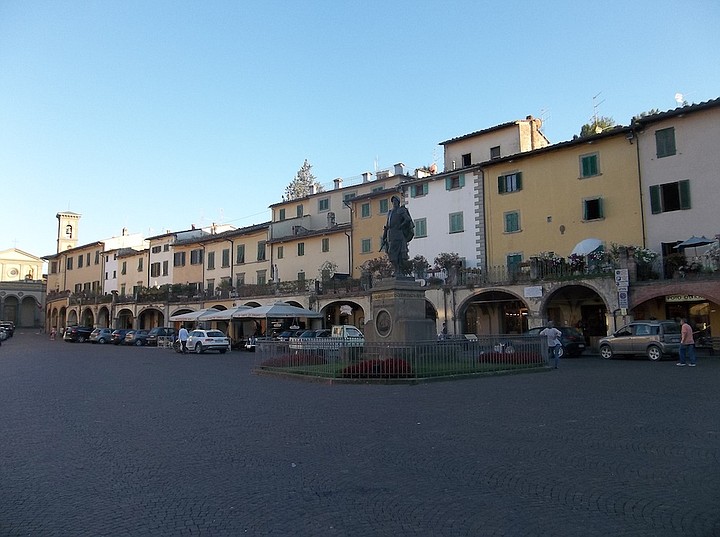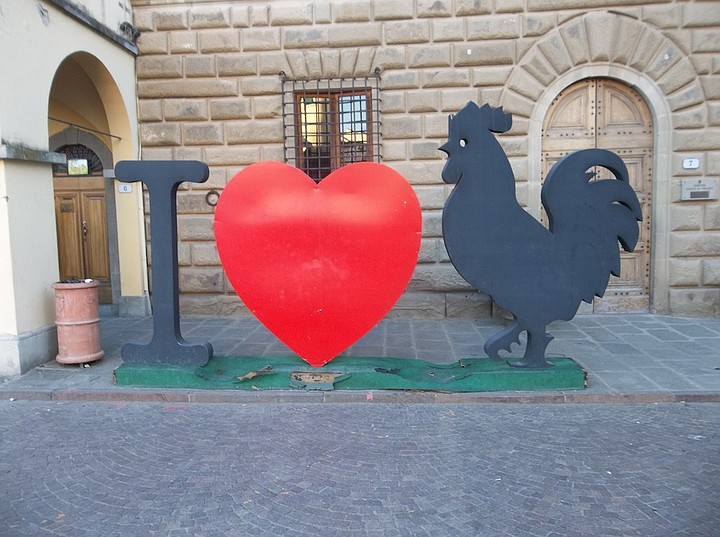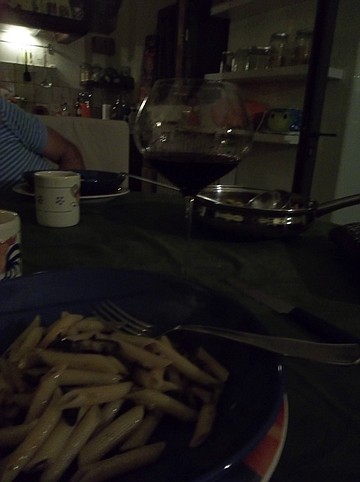 Facebook
Facebook
 X
X
 Instagram
Instagram
 TikTok
TikTok
 Youtube
Youtube

While visiting Florence, I took the opportunity to spend a few nights in a little town about 30 kilometers to the south called Greve in Chianti. The Chianti region, well known for its Chianti Classico red wine, is, as you might expect, replete with acres of scenic vineyards.

My host, Paolo, picked me up at the bus stop in the pocket-sized town and drove to his house alongside a long stretch of vineyards carrying the grapes of the famous Tuscan vino. The green and golden hills, rolling to the horizon, glowed under the afternoon sun. Eventually we reached an unpaved road that led to his house with a glorious view of the Tuscan countryside.
My first night at Paolo’s, we had dinner on the outside patio with his housemate Matteo. The evening was quiet, allowing us a relaxing, insightful conversation to complement the delicious pasta Paolo prepared with eggplant (melanzane in Italian) and other vegetables, garlic and olive oil. He told me the name of the pasta was pasta alla Norma. We of course washed the meal down with a flask of red Chianti.
“The local grapes are Sangiorese grapes,” Paolo explained. “It means blood of Jove, the pagan god. This is the essence of the Chianti wine.”
Paolo knows what he’s talking about when he discusses wine or pasta. A former restaurant owner, he now runs a flower shop (“less stress”) and moonlights as a wedding planner. He commutes to his shop just outside of Florence, but enjoys living in the quiet village atmosphere of Greve.
“Did you hear the deer early this morning?” Paolo asked me the following morning at breakfast. “They make a barking sound.”
“No. A barking sound? I replied, perplexed and wondering if this was just a language mix up. Paolo apologized, explaining that his English was not up to the standards of his Italian, French or Spanish. (How many people do you know that speak four languages?) But it turns out it wasn’t a language error. There are Eurasian Roe deer in the area that make a barking sound.
“What other wildlife do you have around here?”
“Wild boar. They tend to run wild around here, causing problems for plants and gardens.”
Boar is actually considered a delicacy in this part of Italy. Winter is hunting season for wild boar in Tuscany, as it's felt that the population must be controlled.

The following day, after returning to Greve from a day exploring Florence, I strolled through town to the central plaza, Piazza Matteoti. Along the way I passed a wine museum and several signs advertising wine tasting opportunities and tours through the vineyards.

Piazza Matteoti has outdoor cafes, a huge statue of local hero Giovanni da Verazzano, several buildings dated from medieval days, and a sign featuring a black rooster (left), the 700-year-old symbol of Chianti. A genuine bottle of Chianti Classico always has a black rooster on the seal with either a red border indicating the wine is meant to be enjoyed now, or a gold border, indicating that the wine is meant to age several years.
Flipping through a book about the region, I discovered the legend behind the rooster. Greve was once an important market town in the Middle Ages between Florence and Siena. The two rival cities could not agree on where the border should be to determine who would control Chianti. They came up with a solution to avoid bloodshed (somewhat amazing for that time period):
A rider would leave each town by horse and where they met is where the border would be. Florence chose a black rooster as its timekeeper, while Siena chose a white rooster. The morning of the race, the crowing of the black rooster awoke the Florentine rider before dawn so he got an early start on the ride. Thus, Florence controlled Chianti and the bird became an immortal symbol of the local wine.
I assumed the story was just fictional legend, but Paolo told me “I think it’s probably true.”

We capped off my stay with another memorable Tuscan dinner of wine, pasta and conversation. Paolo prepared a pasta called crudaiola with garlic, tomatoes, olive oil, salt cheese and basil, all raw. Delicious!
September features a Chianti Classico wine festival, but the area around Greve is not just famous for its wine. An excellent Tuscan olive oil is also produced here. Olive oil tasting with bruschetta is a major draw for olive oil aficionados.
If sleeping in a quiet spot (notwithstanding the barking deer) in the Tuscan countryside surrounded by the aforementioned vineyards appeals to you, there are several bed and breakfast options in the area, including two within a stone’s throw of Paolo’s home.
There are also some hillside castles in the area. Castello Vicchiomaggio attracts people across the world for weddings under the Tuscan sun. If you’re considering a Tuscan wedding, you can get more information from Paolo through his website, violamalva.it.


While visiting Florence, I took the opportunity to spend a few nights in a little town about 30 kilometers to the south called Greve in Chianti. The Chianti region, well known for its Chianti Classico red wine, is, as you might expect, replete with acres of scenic vineyards.

My host, Paolo, picked me up at the bus stop in the pocket-sized town and drove to his house alongside a long stretch of vineyards carrying the grapes of the famous Tuscan vino. The green and golden hills, rolling to the horizon, glowed under the afternoon sun. Eventually we reached an unpaved road that led to his house with a glorious view of the Tuscan countryside.
My first night at Paolo’s, we had dinner on the outside patio with his housemate Matteo. The evening was quiet, allowing us a relaxing, insightful conversation to complement the delicious pasta Paolo prepared with eggplant (melanzane in Italian) and other vegetables, garlic and olive oil. He told me the name of the pasta was pasta alla Norma. We of course washed the meal down with a flask of red Chianti.
“The local grapes are Sangiorese grapes,” Paolo explained. “It means blood of Jove, the pagan god. This is the essence of the Chianti wine.”
Paolo knows what he’s talking about when he discusses wine or pasta. A former restaurant owner, he now runs a flower shop (“less stress”) and moonlights as a wedding planner. He commutes to his shop just outside of Florence, but enjoys living in the quiet village atmosphere of Greve.
“Did you hear the deer early this morning?” Paolo asked me the following morning at breakfast. “They make a barking sound.”
“No. A barking sound? I replied, perplexed and wondering if this was just a language mix up. Paolo apologized, explaining that his English was not up to the standards of his Italian, French or Spanish. (How many people do you know that speak four languages?) But it turns out it wasn’t a language error. There are Eurasian Roe deer in the area that make a barking sound.
“What other wildlife do you have around here?”
“Wild boar. They tend to run wild around here, causing problems for plants and gardens.”
Boar is actually considered a delicacy in this part of Italy. Winter is hunting season for wild boar in Tuscany, as it's felt that the population must be controlled.

The following day, after returning to Greve from a day exploring Florence, I strolled through town to the central plaza, Piazza Matteoti. Along the way I passed a wine museum and several signs advertising wine tasting opportunities and tours through the vineyards.

Piazza Matteoti has outdoor cafes, a huge statue of local hero Giovanni da Verazzano, several buildings dated from medieval days, and a sign featuring a black rooster (left), the 700-year-old symbol of Chianti. A genuine bottle of Chianti Classico always has a black rooster on the seal with either a red border indicating the wine is meant to be enjoyed now, or a gold border, indicating that the wine is meant to age several years.
Flipping through a book about the region, I discovered the legend behind the rooster. Greve was once an important market town in the Middle Ages between Florence and Siena. The two rival cities could not agree on where the border should be to determine who would control Chianti. They came up with a solution to avoid bloodshed (somewhat amazing for that time period):
A rider would leave each town by horse and where they met is where the border would be. Florence chose a black rooster as its timekeeper, while Siena chose a white rooster. The morning of the race, the crowing of the black rooster awoke the Florentine rider before dawn so he got an early start on the ride. Thus, Florence controlled Chianti and the bird became an immortal symbol of the local wine.
I assumed the story was just fictional legend, but Paolo told me “I think it’s probably true.”

We capped off my stay with another memorable Tuscan dinner of wine, pasta and conversation. Paolo prepared a pasta called crudaiola with garlic, tomatoes, olive oil, salt cheese and basil, all raw. Delicious!
September features a Chianti Classico wine festival, but the area around Greve is not just famous for its wine. An excellent Tuscan olive oil is also produced here. Olive oil tasting with bruschetta is a major draw for olive oil aficionados.
If sleeping in a quiet spot (notwithstanding the barking deer) in the Tuscan countryside surrounded by the aforementioned vineyards appeals to you, there are several bed and breakfast options in the area, including two within a stone’s throw of Paolo’s home.
There are also some hillside castles in the area. Castello Vicchiomaggio attracts people across the world for weddings under the Tuscan sun. If you’re considering a Tuscan wedding, you can get more information from Paolo through his website, violamalva.it.
Comments